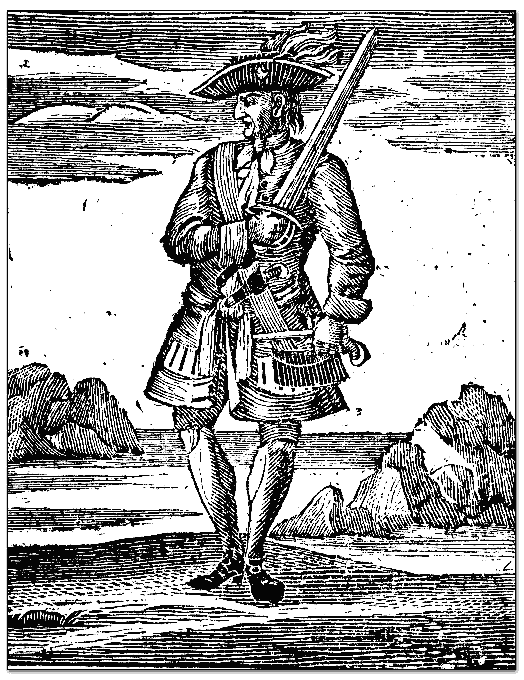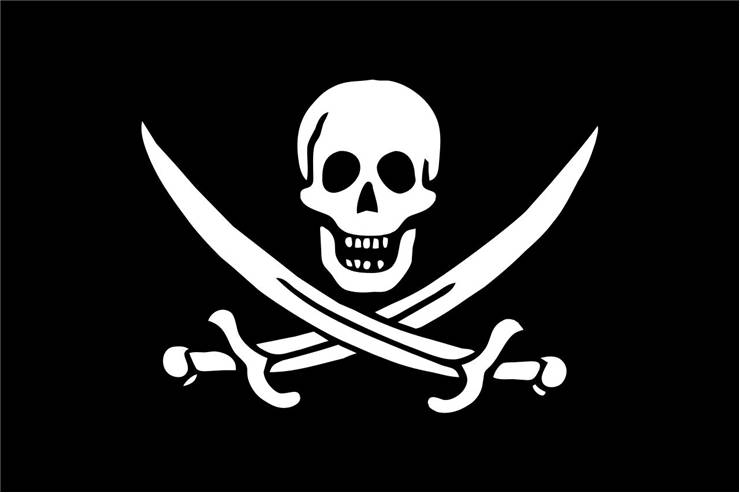Famous Pirate: Calico Rackham Jack
Anne's and Marry's captain
Calico Jack was one of the most unique pirates that ever sailed on the Caribbean during the height of the Golden Age of Piracy. He was not a great fighter, and he never managed to grab incredible wealth, but modern public remembers him more than many other true pirate legends.
John "Jack" Rackham (born on 26 December 1682, died on 18 November 1720) did not manage in his short career as a Caribbean pirate where he gained nickname "Calico Jack" to amass incredible wealth or respect that many other pirates managed to do so, but his associations with other pirates and his unique pirate that had two female pirate crew members managed to make him one of the best remember pirates of all time. He was not regarded as the great fighter or fierce naval tactician, but his cunning mind and tendency to use backstabbing and politics to further his goals made him one of most unique pirates on the seas of Caribbean.
The written publications after his death contributed greatly to the rise of his fame, and the eventual rise of the movement that romanticized pirate life enabled the myth of Calico Jack to grow. Another important impact that Calico Jack had on the modern image of pirates is his Jolly Rogers flag. While the majority of pirate crews used designs that had a depiction of full human skeletons using some weapon, Calico Jack promoted an iconic pirate flag design that today represents a synonym for a naval piracy - black flag with white human skull and two white crossed swords beneath it.
Captain Rackham earned his fame during the height of the ‘Golden Age of Piracy’
The early history of John Rackham's life is sadly no recorded in modern history. What is known is that he was born in England on 26 December 1682 and that he (and presumably his family) moved to the New World around the start of 18th century. The first historical recording of his presence in the New World comes from the crew manifest of pirate ship "The Ranger" under the command of Captain Charles Vane (1680 - 1721), where Rackham served as a quartermaster. Captain Vane as one of the few famous pirates that operated out of the pirate heaven and trading base "New Providence" located in the Bahamas. The rise of the influence of Jack Rackham happened in 1718 after Captain Vane decided to retreat after at the end of the long pirate run he confronted large French warship that was least twice of the size of The Ranger. Vane was a seasoned sea commander at that time, and he saw that attacking such a large vessel was an impossibility for his small ship that recently went through several pirate raids and was in need of repair and resupply.
The retreat caused discord in the crew, with Rackham taking charge in accusing Vane of poor decision making. In the end of the discussion, 15 crew members supported Vane in the retreat, while the other 75 argued that if captured the French vessel would not only bring them large riches but also a new base of operation that would enable them to become pirate crew with one of the largest and best-equipped ship in the Caribbean. On November 24, 1718, Rackham called to the vote in which Vane was removed from captaincy and branded as a coward. The crew promptly elected John "Calico Jack" Rackham to be a new captain of The Ranger, while Vane and his supporters were allowed to leave on a small ship carrying a supply of food and ammunition.
After being promoted to a position of a captain, Calico Jack continued with the pirate runs that were mostly oriented toward smaller merchant and passenger transport vessels. During one of his numerous runs he managed to gain control of the several larger ships, but the largest prize he ever managed to snatch happened to be from withing the holds of the large Jamaican vessel Kingston. He fought and captured this vessel with skill, but sadly for him, this battle happened within sight of the Port Royal harbor, in view of all the government officials and merchants stationed there. Outraged by the deeds of the now semi-notorious pirate, merchants in that city joined and outfitted pirate hunting Spanish ship with the task to capture and punish Captain Calico Jack. The events that followed were disputed by some historians, but eventual result was that Captain Jack and his crew managed to avoid the hunt. According to the report written by the Captain Charles Johnson in his 1722 book "A General History of the Robberies and Murders of the most notorious Pyrates", John Rackham avoided Spanish pirate-hunting ship by taking advantage of the low tide that prevented Spanish warship from approaching anchored pirate sloop near the shore of the Cuba. During the night, Calico Jack and his crew managed to row with boats to the small sloop captured by the Spanish that was anchored near the warship. They overpowered guards on it and sailed away, with Spanish Warship noticing the pirates were gone only in the morning when it was too late to pursue them. Other accounts of that tale tell of the different events where Spanish pursuers managed to ambush Calico Jack's flagship Kingston that was anchored near the Isla de Los Pinos off of Cuba. Rackham and most of his men avoided capture by hiding on the shore and waiting until pirate hunting ships left taking with them all their possessions, including all their rich plunder.
Faced with this severe setback, Captain Jack, and his crew decided to take advantage of the new amnesty deal offered by the English government (particularly, in this case, new Governor of Bahamas Woodes Rogers) in which all pirates could continue living as free men as long they gave up life of the piracy and privateering. They traveled to Nassau where they pleased their case to the authorities, describing how Captain Charles Vane forced them all to become pirates. Governor Woodes Rogers accepted their plea, partly because he was tasked by higher authorities to make serious effort into solving piracy issue in the Caribbean waters, but also because of his strong hatred toward Charles Vane. John Rackham and his pirates were given Royal Pardon, with the stipulation that they will be put to death if they ever again returned to piracy. However, the lure of the sea was too strong for many of them, and John Rackham did not remain law abiding citizen for too long.
Famous Anne Bonny had a short but notable pirate career at Rackham’s ship
During his stay in Nassau, Rackham became restless and found trouble by having a affair with Anne Bony, wife of the sailor James Bonny who was also under employment by the Governor Rogers's office. After the discovery of the affair, furious James Bonny pleaded to the governor to punish his wife with flogging, but John Rackham intervened offering money to him to divorce her legally. With no peaceful solution found, Rackham and Anne Bonny decided to void his Royal Pardon by stealing sloop from the harbor and fleeing once again to the life of piracy. Anne Bonny became openly part of the pirate crew, by hidden among the pirate crew members was also Mary Read, another female pirate who at first hid her gender from other pirates by disguising as a man. Captain Jack and his lover Anne Bonny.
Back to the sea again, Captain Calico Jack and his crew started their usual runs against merchants across the Caribbean. In addition to targeting only merchants, Calico Jack also attacked few smaller pirate vessels, not with a goal of thinning out the competition, but to offer them ability to join his crew. With ever expanding force of pirates under his command, Calico Jack in just two months managed to cause chaos in the Caribbean. By late 1720, Bahamas' Governor Woodes Rogers issued the official proclamation that marked Rackham and his entire crew as pirates. Pirate hunter Jonathan Barnet immediate sprang into action, sailing toward Jamaica where reports claimed that Rackham has recently captured several small fishing vessels. In October 1720, Captain Jonathan Barnet located Calico Jack's anchored sloop of the coast of Bry Harbour Bay in Jamaica. He managed to surprise pirates who were at that time partying and drinking after a successful round of plundering. Reports say that in the melee fight that ensued, the pirate crew was led by none other by Mary Read and Anne Bonny. However, this struggle was short-lived, eventually leading to the capture of entire John Rackham crew. Captain Jonathan Barnet transported them all to the Spanish Town, Jamaica, where all of them were tried for piracy and sentenced to the death by hanging. Captain John "Calico Jack" Rackham was executed 18 November 1720 in Port Royal. He was hanged, gibbeted, and put on display on a small islet (today know as Rackham's Cay) near the entrance of the harbor of Port Royal to serve as an example to all Pirates on the Caribbean waters. Captain Charles Johnson recorded in his book "A General History of the Robberies and Murders of the most notorious Pyrates" a very famous comment that Anne Bonny said about Rackham: "If he had fought like a Man, he need not have been hang'd like a Dog".
As for the remainder of his crew, all male members were hanged to death, while two females Anne Bonny and Mary Reid were held in prison for several weeks until their claims of pregnancy could be verified. Reports say that Mary Read died in April 1721 while in prison, while all records Anne Bonny stopped. Her fate remains unknown to this day, although some claim that he was released from prison and she lived a peaceful life on shore until she died from old age.

